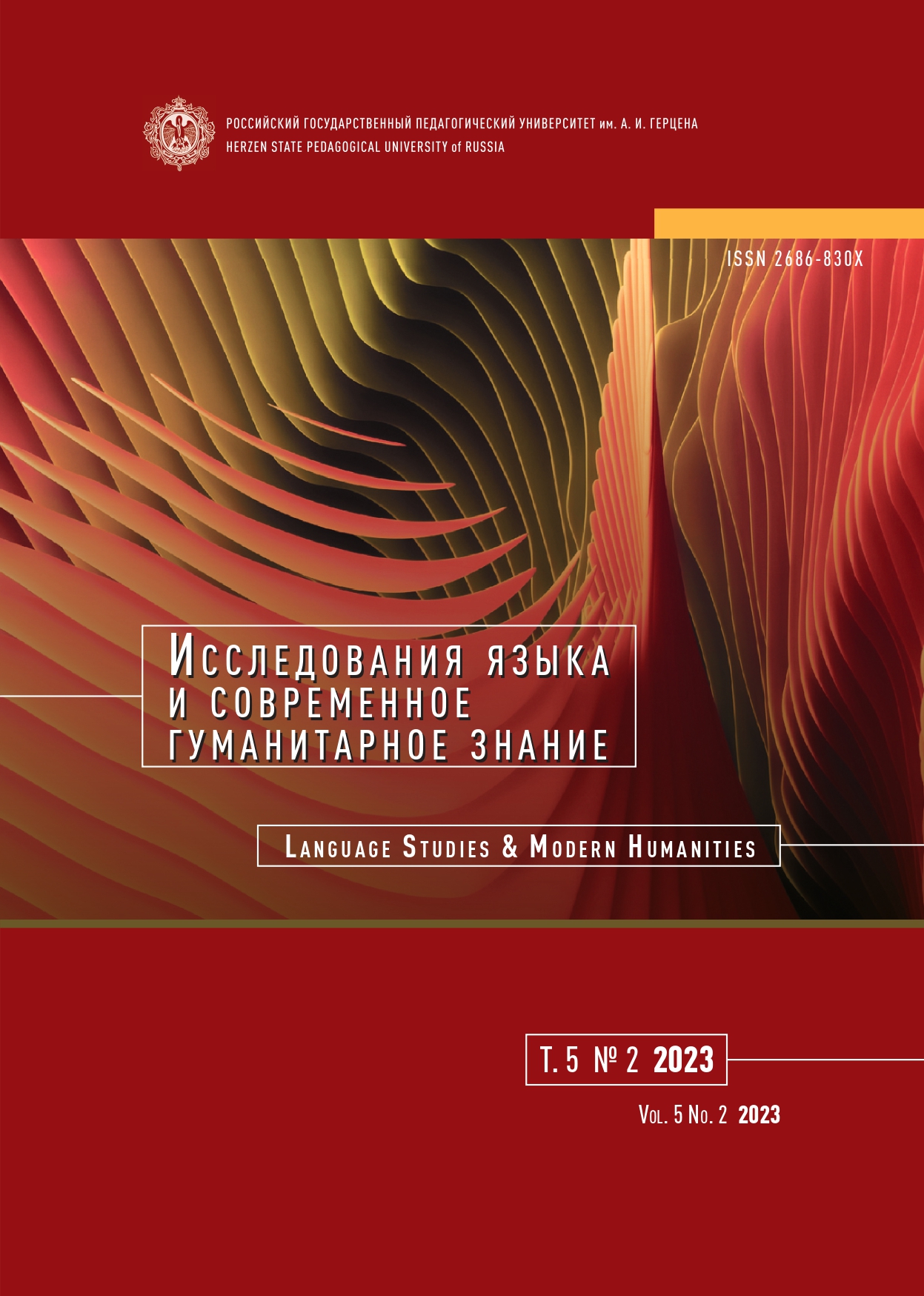The phenomenon of homonymy of new borrowings in the modern Russian language
DOI:
https://doi.org/10.33910/2686-830X-2023-5-2-106-112Keywords:
borrowing, homonymy, homonyms, new borrowings, LSVAbstract
At the turn of the 20th–21st centuries, the Russian language observed active borrowing of foreign language lexical units, which becomes one of the potential sources of replenishment of the vocabulary of the Russian language at the present stage. This phenomenon is constantly under the close attention of many linguists. This article is devoted to the consideration of new borrowings in the modern Russian language in their ononymous relations. Homonymy is considered a typical lexical-semantic phenomenon in borrowings, which expresses the influence of foreign words and their great role in the process of enriching and diversifying the stock of Russian vocabulary. The purpose of this work is to consider and describe the features of new homonym borrowings in the lexical and semantic aspect. To achieve this goal, it is necessary to solve the following tasks: consider the theoretical foundations of homonymy and homonyms; present a lexical-semantic classification of homonym borrowings depending on their origin and form. The main methods in this study, determined by the purpose and objectives of the work, were the method of linguistic description, the method of lexical-semantic analysis, the classification method, the directed sampling method, the method of component analysis, as well as the statistical method. The scientific novelty of this article is determined by the fact that it conducts a special and in-depth study of borrowed words in their omonymous relationships in the lexical-semantic aspect. The novelty of the article also lies in the selection of examples for analysis — new vocabulary of foreign origin at the turn of the late 20th — early 21st centuries, taken from new dictionaries of foreign words, which contain new borrowings in the modern Russian language.
References
ЛИТЕРАТУРА
Будагов, Р. А. (2003) Слово и его значение. 2-е изд. М.: Добросвет-2000, 62 с.
Крысин, Л. П. (2008) Толковый словарь иноязычных слов. М.: Эксмо, 944 с.
Новиков, Л. А. (1982) Семантика русского языка. М.: Высшая школа, 272 с.
Словарь современной лексики, жаргона и сленга. (2023) Академик. [Электронный ресурс]. URL: https://argo.academic.ru/ (дата обращения 08.11.2023).
Толковый словарь Ушакова. (2023) Gufo.me. [Электронный ресурс]. URL: https://gufo.me/dict/ushakov (дата обращения 08.11.2023).
Что значит байтить и кто такой байтер? Объясняем! (2017) Bestcube, 23 октября. [Электронный ресурс]. URL: https://bestcube.space/chto-oznachaet-bajt-i-bajtit (дата обращения 08.11.2023).
Шагалова, Е. Н. (2017) Словарь новейших иностранных слов. М.: АСТ-Пресс, 571 с.
REFERENCES
Budagov, R. A. (2003) Slovo i ego znachenie [The word and its meaning]. 2nd ed. Moscow: Dobrosvet-2000 Publ., 62 p. (In Russian)
Chto znachit bajtit’ i kto takoj bajter? Ob’yasnyaem! [What does it mean to byte and who is a byteer? Explained!]. (2017) Bestcube, 23 October. [Online]. Available at: https://bestcube.space/chto-oznachaet-bajt-i-bajtit (accessed 08.11.2023). (In Russian)
Krysin, L. P. (2008) Tolkovyj slovar’ inoyazychnykh slov [Explanatory dictionary of foreign words]. Moscow: Eksmo Publ., 944 p. (In Russian)
Novikov, L. A. (1982) Semantika russkogo yazyka [Semantics of the Russian language]. Moscow: Vysshaya shkola Publ., 272 p. (In Russian)
Shagalova, E. N. (2017) Slovar’ novejshikh inostrannykh slov [Dictionary of the latest foreign words]. Moscow: AST-Press, 571 p. (In Russian)
Slovar’ sovremennoj leksiki, zhargona i slenga [Dictionary of modern vocabulary, jargon and slang]. (2023) Akademik [Academic]. [Online]. Available at: https://argo.academic.ru/ (accessed 08.11.2023). (In Russian)
Tolkovyj slovar’ Ushakova [Ushakov’s explanatory dictionary]. (2023) Gufo.me. [Online]. Available at: https://gufo.me/dict/ushakov (accessed 08.11.2023). (In Russian)
Downloads
Published
Issue
Section
License
Copyright (c) 2024 Mai Chi Tran

This work is licensed under a Creative Commons Attribution-NonCommercial 4.0 International License.
The work is provided under the terms of the Public Offer and of Creative Commons public license Creative Commons Attribution 4.0 International (CC BY 4.0).
This license permits an unlimited number of users to copy and redistribute the material in any medium or format, and to remix, transform, and build upon the material for any purpose, including commercial use.
This license retains copyright for the authors but allows others to freely distribute, use, and adapt the work, on the mandatory condition that appropriate credit is given. Users must provide a correct link to the original publication in our journal, cite the authors' names, and indicate if any changes were made.
Copyright remains with the authors. The CC BY 4.0 license does not transfer rights to third parties but rather grants users prior permission for use, provided the attribution condition is met. Any use of the work will be governed by the terms of this license.







